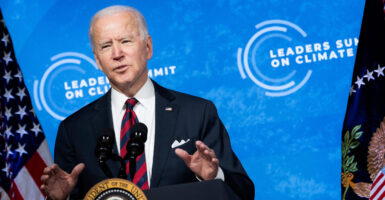In anticipation of the virtual Leaders Summit on Climate, a two-day global gathering of more than 40 world leaders, President Joe Biden declared that the United States had a “moral imperative” to adopt an “ambitious” goal of cutting greenhouse gas emissions by 50% from 2005 levels by 2030 and 100% by 2050.
Such an effort, if we were serious about it, would entail massive destruction of wealth, a surrender of our international trade advantages, the creation of a hugely intrusive state-run bureaucracy at home, the inhibition of free markets that have helped make the world a cleaner place, and a precipitous drop in the living standards of most citizens—especially the poor.
Of course, it should be said that those who oppose the expansion of fracking and nuclear energy—most elected Democrats, it seems—aren’t even remotely serious about “tackling” carbon emissions anyway.
Around 80% of American energy is generated by fossil fuels and nuclear right now. Around 20% is generated by “renewables”—predominantly wind and hydropower (which is unavailable in most places). Only around 2% of our portfolio consists of inefficient and unreliable solar power—this, even after decades of subsidies and mandates.
It’s always funny to hear people speak about solar panels as if they were some sort of cutting-edge technology. The discovery of the photovoltaic effect goes back to 1888.
President Jimmy Carter declared a national “Sun Day” in 1978 and put 30 solar panels atop the White House. One of those panels is now on display at the Science and Technology Museum in China—not only the top producer of solar panels and carbon emissions but also the nation that would most benefit from the United States’ unilateral economic capitulation.
To reach Biden’s goal, the United States would need to envelop most of the nation in panels and windmills and then rely on enormous Gaian prayer circles—may she grant us sunshine and gale-force winds. We would be compelled to eliminate most air travel and cars—making new ones produces lots of carbon emissions—and retrofit every home, factory, warehouse, and building in America to utilize this type of energy. We would need to dramatically cut back on our meat and dairy intake as well.
“The signs are unmistakable, the science undeniable,” Biden claimed. “Cost of inaction keeps mounting.”
Now, I realize that people repeat these contentions with religious zeal, but the evidence is extraordinarily weak. For one thing, there is action. Market innovations keep creating efficiencies all the time. For another, we live in the healthiest, most equitable, most prosperous, most safe, and most peaceful era in human existence. Affordable fossil fuels have done more to eliminate poverty than all the redistributionist programs ever concocted.
By nearly every quantifiable measure, the environment is also in better shape now than it was 20, 30, or even 50 years ago. A lot of that is grounded by an economy that relies on affordable energy. Also, though every weather-related event is framed in a cataclysmic way, not that long ago, being killed by the climate was serious concern for most people. Today, it is incredibly rare.
Progressives, however, regularly maintain that we are facing an existential crisis. One might point out that science’s predictive abilities on climate have been atrocious. But really, these days, “science” is nothing but a cudgel to push leftist policy prescriptions with little consideration for trade-offs, reality, or morality.
The Malthusian fanaticism that’s been normalized in our political rhetoric is also denialism. “Science,” as the media and political class now practice it, has become little more than a means of generating apprehension and fear about progress. It is the denial of the modern technology and competitive markets that continue to allow human beings to adapt to organic and anthropogenic changes in the environment.
Even people who mimic doomsday rhetoric seem to understand this intuitively. The average American says they are willing to spend up to $177 a year to avoid climate change, not the approximately $177,000,000 per person it would cost to set arbitrary dates to get rid of a carbon energy economy.
The choice we’re given now pits a thriving open economy against an economy weighed down by centralized (and unratified) worldwide climate change treaties such as the Paris climate agreement that put little burden on growing economies such as China and India, and all of it on you.
What does that burden look like? After shutting down a large chunk of its economy in 2020, and spending trillions to keep those affected afloat and avert a depression, the United States emissions only fell by 13%. Imagine what 50% might entail.
When confronted with these nagging specifics, we often hear how these are aspirational goals. Why would we aspire to make life worse for billions of people?
COPYRIGHT 2021 CREATORS.COM
The Daily Signal publishes a variety of perspectives. Nothing written here is to be construed as representing the views of The Heritage Foundation.
Have an opinion about this article? To sound off, please email letters@DailySignal.com and we will consider publishing your remarks in our regular “We Hear You” feature.



























